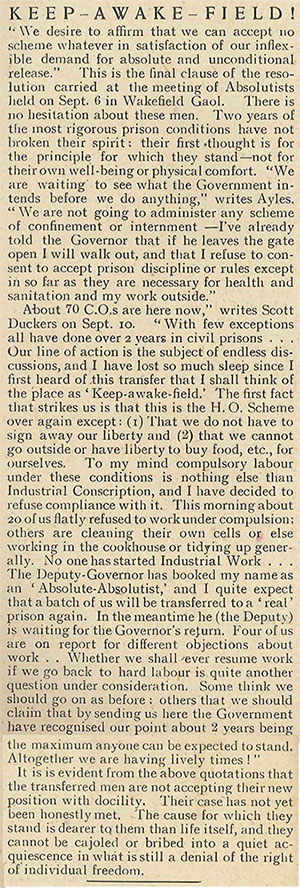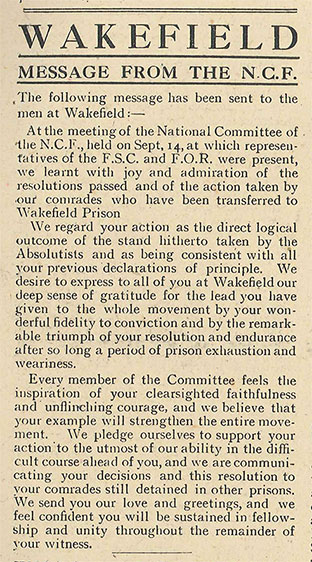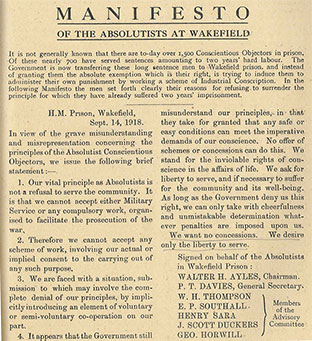
| HOME | TRIBUNAL HOME |
September 1918
August 1918 had been a month of settling down. The status and conditions of conscientious objectors, whether in prison, working as non-combatants in the army, or engaged on work of national importance seemed to be resolved. The war, now rapidly coming into it’s final stages, seemed to promise a final release from Conscription, though persecution of COs and their supporters continued unabated. So did the continual political pressure exerted on the government by the CO movement. Sympathetic MPs continued to call for better conditions, treatment and increasingly, now the manpower crisis of early 1918 had passed, the release of long-term prisoners of conscience. The government, still searching for a way to quieten CO supporters without releasing men entirely, came up with a new (and short lived) scheme that would dominate the Tribunal in September: the Wakefield Experiment.
12th September: New Conditions at Wakefield
The month started with rumours that a new way of dealing with Absolutist Objectors was on the horizon. Coming off the back of the “two year men” release program rolled out earlier in the year, men who were long-standing COs who had already served multiple sentences were being gathered into groups in prisons around the country. With little scope for gathering the official version of events, the Tribunal reported news from letters sent from prisons:
“From Durham prison news has arrived that 10 Absolutists, all of whom had served more than 2 years in prison were notified on Friday August 30th, that they were to be transferred to Wakefield Civil Prison”
These men were given no choice, and little chance to inform anyone of their whereabouts. Prison officials at Durham had no idea of the conditions at Wakefield, and for many, it would have seemed to be simply another prison transfer. More men would be transferred from Dorchester prison.
The article covering the rumours gives all the details it can, but the picture emerging was mysterious - men wore civilian clothing, allowed to see visitors and accept parcels, letters and food from them. Conditions even seemed to be better upon arrival at Wakefield. Locks had been removed from the prison doors and they had freedom of movement within the prison itself. They could even freely buy writing materials and tobacco with a little pocket money. The conditions seemed good - not a full release, but certainly better than prison. The mystery was in why it had all happened - and in the selection of certain men for transfer.
19th September - Summary of the Position of Absolutists at Wakefield
With writing material available to the men in Wakefield, and presumably restrictions on letters and communication lifted, a week later the Tribunal was able to report in some detail on the experience and conditions on the new system. The (temporary) prison regulations had been sent out, with an accompanying note of caution that there were “no definite regulations for their treatment as yet”. Assigned work was largely concerned with maintaining the prison, and the Deputy-Governor had even suggested cooperative work in setting up an adequate canteen.
The rules that would govern life at Wakefield seem largely sensible. COs would have dedicated free time and working hours, they could not damage prison property and could smoke fairly freely. The only article for concern seemed to be that working hours demanded diligence and could not include “singing, shouting, whistling or reading”.
From the point of view of the Governor (and government), the conditions of the scheme would have seemed reasonable. If long-serving COs could expect similar treatment around the country, it must have appeared that the problem of the Absolutists was at long last solved.
19th September - Keep-Awake-Field!
The largely liberal rules at Wakefield did not meet with universal support among the men experiencing them. Keep-Awake-Field draws on letters sent by Walter Ayles and Scott Duckers directly to the NCF, informing them of the conditions at Wakefield, and the thoughts of the Absolutists held there.
 Uncertainty prevails, as Ayles explains:
Uncertainty prevails, as Ayles explains:
“We are waiting to see what the Government intends before we do anything. We are not going to administer any scheme of confinement or internment... I refuse to consent to accept prison discipline or rules”
and Duckers expands:
“Our line of action is the subject of endless discussions... The first fact that strikes us is that this is the H.O.Scheme over again except: 1) That we do not have to sign away our liberty and 2) that we cannot go outside or have liberty to buy food etc for ourselves”
A critic may perhaps point out that 2) follows on from 1) there, but it is clear that neither men in Wakefield or the Governor of the prison really knew what was going on. Opinion was divided as to why COs were there in the first place - either to put them under industrial conscription, or to segregate these “Absolute-Absolutists” from the general population, or perhaps even to acknowledge that the prison system had failed.
One thing is clear from both letters - the COs at Wakefield would not be put to work. Though uncertain as to what the future held, they would resist any attempt to force them to carry out compulsory labour, and the threat of a work-strike began to form around the prison. After more than two years of prison, Absolutists were not about to compromise now - even in the seemingly limited way demanded of them at Wakefield.
26th - The Wakefield Experiment Collapses
It only took one more week for mystery to resolve into fact, and for the Wakefield Experiment to come crashing to an end. The Tribunal covered it in great detail.
After a period of settling in, the Wakefield men had taken it upon themselves to organise and run the prison as they wished. Committees (and sub-committees, those great favourites of peace movements since time immemorial), divided the labour of prison upkeep and cordially invited the wardens to help if they wished. The Governor, with no instructions on what to do, allowed the Chairman of the Committee, Walter Ayles, to represent the official Home Office plan for the prison to the assembled men. Ayles presented the rules and regulations on how COs in Wakefield would be expected to work and live on September 16th. There had been no great threat of exceptional mass punishment, simply that if the rules of the new scheme were not followed, men would be returned to prison. The position was simple. In exchange for their work, COs would stay in Wakefield and be managed, in all essential respects, by themselves.
Two days later, with a resounding rejection of the principle of compromising conscience for better conditions, all but six of the 123 Objectors were back in locked cells, soon to be returned to the prisons they came from.
The final piece was the creation of the “Manifesto of the Absolutists at Wakefield”. Not only had the COs held there organised and discussed their thoughts, but had formed a Committee which wrote, drafted and distributed a clear statement of intent. The Manifesto signalled the clearest statement of the Absolutist position. Despite better conditions, no manner of compromise would fulfil the aim of the Absolutists: unconditional liberty and discharge from the army. The Manifesto explained that the government:
“take for granted that any safe or easy conditions can meet the imperative demands of our conscience. No offer of schemes or concessions can do this. We stand for the inviolable rights of conscience in the affairs of life.”
The 123 men at Wakefield refused any form of compromise with the government and demanded either release, or a return to prison. No change in their circumstances could win them over and put them to work.
The position outlined in the Manifesto had been the Absolutist stance since before Conscription had become law, and the rejection of the Wakefield Experiment was the last attempt by the government to subvert or undermine it. The Wakefield men returned to prison, and the incarceration of Conscientious Objectors continued as before.
Clink on images to enlarge

